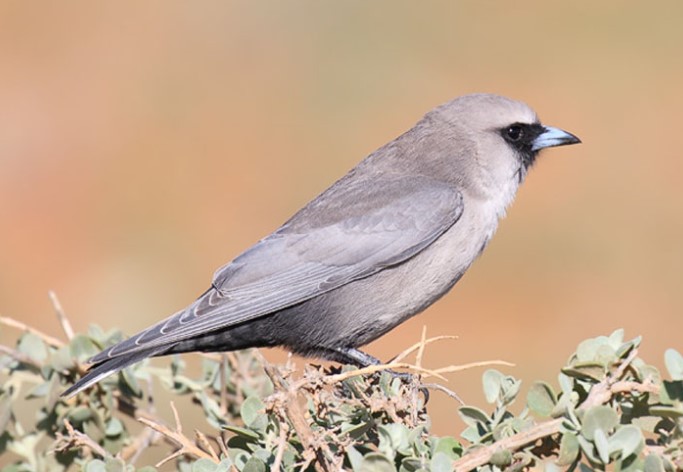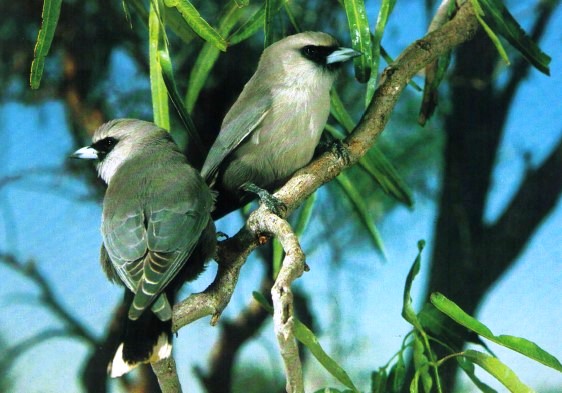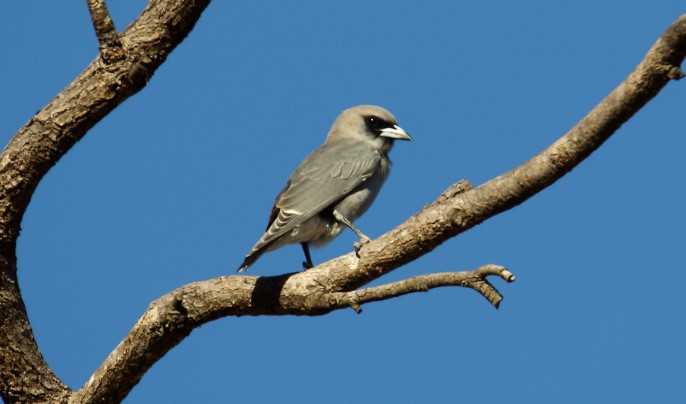Like other wood swallows, the Black-faced Woodswallow (Artamus cinereus) captures aerial insects. The bird is also known as grey-breasted woodswallow, white-bellied woodswallow, and white-vented woodswallow. This bird is replacing the Dusky Woodswallow on the open, shrubbed plains of inland Australia and in the drier tropical northern woodlands. The bird belongs to the family Artamidae.
They are neat birds with a smoky bloom to their plumage, grooming with power downs hidden in the birds’ flanks. Flight is unforced, on broad, pointed wings with short wrists, but their feet are weak. On branches, the birds can do no more than shuffle, and on the ground, where they land to pick up swarming insects or nest material, they hop weakly. Black-faced woodswallows are 180–190 mm in length.

Black-faced Woodswallows are rather sedentary birds despite their often unpredictable environment, keeping to the same local foraging range year in, year out. Like Dusky Woodswallows, they live in small communal groups of several pairs plus their immediate progeny. Bouts of foraging are broken with occasional huddles and mutual preening as several birds land to sit together, tails wagging and rotating, on a bare branch.
However, they are usually more spaced out than other wood swallows. At night, all members cluster to roost, cramming in a tight ball into sheltering hollows and tree crotches. When hunting, they rarely hawk high for long periods but sally out in brief low sorties from vantage perches-the top of a post or bush or a dead branch top. They circle and soar, hover, and float, catching insects with bills and feet in midair and eating them there.

In this way, groups work through their range each day, twittering constantly on the wings and from perches to keep contact. Like other wood swallows with white-tipped tails, pairs court by mutual wing-waving and tail-rotation. Nests are built in six days. Both parents build, the nest, incubate, and feed the young, and they may be helped by other unmated birds in their group.
ADULTS: Both sexes are similar. The head and back are light, smoky grey; the rump is black. Wings are blue-grey, white beneath. The tails are black. All feathers except the central pair are tipped broadly white in Australia. Both the eyelashes and a small area around the eye and chin are very dark. Underparts are pale, smoky grey; dark or white on vent and undertail coverts, according to race. Their eyes are dark brown. The bill is pale blue-grey with a black tip. The feet are mealy black. The immature birds are coarsely speckled cream on grey-brown as nestlings; speckling persists until the first molt, several months after fledging.

Black-faced woodswallow call is soft, sweet, scratchy chirps in contact, chiff, or chap, chap, mostly given singly or in doublets; harsh chattering in alarm and when mobbing predators. Black-faced woodswallows sing soft, short sounds, including mimicry calls. There is a nesting and breeding season from August to January, sometimes after rain in arid areas. Nest is a shallow, skimpy bowl of twigs, grass stems, and rootlets; placed in a well-hidden fork in a bush, or in the crotch on a stump or fence post. The nest is usually located 1–5 meters above the ground.
The bird lays 3 or 4 eggs; white with purple-brown blotches concentrated at the larger end; oval, about 22 x 17 mm. The incubation period for both sexes is about two weeks long. Young fledge in 18 days. The black-faced woodswallow is found in the drier open woodlands and steppes of Australia, mainly west of the Great Dividing Range. This bird is also present in Timar and New Guinea. Although it is largely sedentary in the summer, it is locally nomadic outside the breeding season. There are three races, but two are found in Australia.
Read More – Masked Woodswallow (Artamus personatus)







